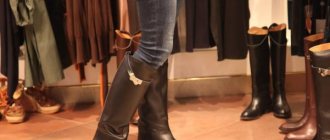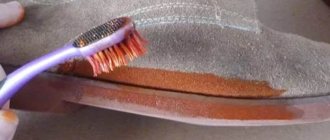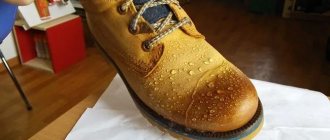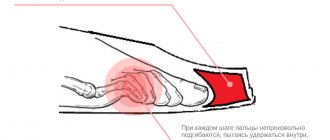Many people, having bought shoes or boots at home, discover that they are too big, and walking in them is completely uncomfortable. But it would be a pity to return them, because they could have been bought on sale for pennies or they could have sunk deeply into their hearts. Don't worry, there are several ways to help reduce or narrow your shoe size. The result depends on the material from which it is made.
Using an insole
You can reduce the size of boots or sneakers, as well as other closed shoes, using an additional insole. If necessary, use several pieces. It all depends on the original shoe size. Insoles of different thicknesses are used. So, in winter it is better to use products made of felt, wool or fur. In this case, 1 insole is enough to adjust the size.
A summer version of similar products is also used: foam rubber, synthetic, leather, etc. They do not allow you to reduce shoes by one size, but can only slightly reduce the level of discomfort when walking. In addition, boots or sneakers will not slip off your feet. You can also put several insoles of this type inside. The effectiveness of this method will immediately increase.
- silicone inserts - used to protect against calluses, but due to a certain thickness they additionally reduce the free space, this method can be used to reduce boots, sneakers and other closed products; such inserts are not installed in high-heeled shoes;
- cotton wool or other filler - a sock is stuffed with this material, you can use rags and even paper;
- double-sided tape - glued to the sole, but this option is not suitable for long-term wearing of shoes, and you need to put it on your bare foot, otherwise the tape will not hold the foot well.
How to make a big leg visually smaller
Some women find it difficult because they wear shoes larger than size 38. To visually make your feet smaller, you need to choose the right shoes:
- avoid products with pointed long toes;
- wear items with heels greater than 5 cm, bows, clasps;
- give preference only to dark tones.
You can reduce the shoe size yourself, but it is better to avoid this, as impacts on the fabric will damage it. Buy only quality products, avoid improper storage, and if the width of the material continues to increase, contact a professional.
Water, drying
Use hot water and dilute a small amount of powder in it. It is important to thoroughly mix the detergent, because if this is not done, then blue or red dots will appear on the shoes - additives containing active ingredients. Then the product is lowered into a container with a soap solution. 5 minutes is enough for the method to work.
The shoes are removed from the water and left in the sun or near a heat source. As the product dries, it will shrink. Then all that remains is to break the shoes in so that they stretch to fit the shape of your feet. However, it is important to remember that shoes can be greatly reduced in this way, so it is important to control the process. So, during drying, it is recommended to try on the product. If they are almost dry, you need to start breaking in the shoes without waiting for them to dry completely. This is what you do when you need to reduce the size a little.
Tips and tricks
Before choosing shoes, you need to stand on paper and trace your feet. The cut out footprints must fit into the boots and shoes you are purchasing and not curl at the edges. Relieves the load on the legs and prevents the curvature of the joints with a deep sock, the wide part of which is located at the level of the big toe. When buying shoes, you need to check the condition of the inside, there should be no seams on it, and the insoles should be easy to remove.
Shoes or boots with hard soles last longer and reduce the load on the foot when walking. When buying shoes, it is advisable to walk around the store in them and sit. If the foot turns red, you should look for a different model or size. Tights or stockings are worn under closed shoes, but not with sandals. Patent leather shoes can only be made smaller by using insoles or overlays. Such products cannot be heated with steam or water.
Nowadays, many people order sneakers or boots online, since on the manufacturer’s website you can buy a suitable model and a high-quality product at a cheaper price. However, the sizes do not always match, and you don’t want to send back the shoes you like, and shipping is not cheap. There are different ways to stretch both shoes and sneakers, but sometimes the question of how to reduce the size of shoes becomes relevant.
Temperature difference
The method of exposure to moisture and drying is used. However, unlike the previously discussed method, this option requires exposing cooled shoes or sneakers to a low temperature. You need to keep them in cold water. After a few minutes, you can take out the shoes and dry them with a hairdryer. An alternative option is to dry it near a radiator.
It is important to ensure a temperature difference. You can cool the water more. For example, in the summer, throw a couple of ice cubes into the liquid. When it melts, sneakers or shoes are immersed in it. They are then dried under a heat source.
Tips and tricks
Before choosing shoes, you need to stand on paper and trace your feet. The cut out footprints must fit into the boots and shoes you are purchasing and not curl at the edges. Relieves the load on the legs and prevents the curvature of the joints with a deep sock, the wide part of which is located at the level of the big toe. When buying shoes, you need to check the condition of the inside, there should be no seams on it, and the insoles should be easy to remove.
Shoes or boots with hard soles last longer and reduce the load on the foot when walking. When buying shoes, it is advisable to walk around the store in them and sit. If the foot turns red, you should look for a different model or size. Tights or stockings are worn under closed shoes, but not with sandals. Patent leather shoes can only be made smaller by using insoles or overlays. Such products cannot be heated with steam or water.
Shoes are an integral part of every person's wardrobe. However, choosing the most suitable model can be quite difficult. In addition, an already purchased pair may stretch out over time. An equally common situation is when, when purchasing through an online store, the purchased model turns out to be too large. However, you shouldn’t get upset and put your shoes in the closet - the situation when the shoes are too big can be corrected.
Rubber
This is a more difficult method to implement, as it requires sewing an elastic band to the inside of the heel. This way you can reduce the size of your sneakers. However, making shoes a size smaller will not work. The patch allows you to only slightly change the parameters of the product. Moreover, pay attention to the thickness of the base material. A heel that is too thick cannot be pierced with a simple needle. It should be remembered that when sewing on the elastic, it is important to make sure that it slightly overlaps the insole.
Shoes do not fit: when can they be returned to the store?
The easiest option is to return the unsuitable purchase immediately on the day of purchase. If you're lucky and the seller remembers you, you can exchange the shoes for a pair of the size you need or get your money back.
According to the Consumer Protection Law, you can return the shoes within two weeks after purchase. But only on condition that the pair is clean, undamaged, and the factory packaging, labels and receipt are preserved. However, do not be upset if the receipt has not been saved - in any case, information about the sale is in the store documentation, and the sellers have a second copy of this document.
You can return shoes to the store using the Consumer Protection Law
The store has the right to exchange shoes you don't like for a more suitable pair with the same or higher price (if you agree to pay extra). If a suitable pair is not available on the day of your request, then you can request a refund of the cost of your purchase, and the amount must be returned within 3 days after your request.
Boots
To change the size, just use additional insoles or fill the sock with any material. However, the shoe model may have a wide top. Sometimes this is provided for by the design, but more often the folds in the boot area need to be aligned due to the structural features of the shin. To do this, use the following methods:
- an elastic band is sewn inside;
- A stitch is made at the back in the area where the boot top is freely located.
Both options are unreliable, because there is no guarantee that the result will be justified. However, there is no alternative to them in everyday conditions.
Traditional methods
Many available products can be no less effective than expensive shoe cosmetics, but they are significantly lower in cost and are the most versatile and safe:
- Freshly squeezed lemon juice or half a lemon helps a lot, rub it on the contaminated area and leave for 5-10 minutes; citric acid easily dissolves such contaminants, after which it is enough to wipe the sole with a damp cloth
- An ordinary stationery eraser can easily handle some adhesive stains; it is especially effective for rubber glue.
- Also, traces of glue from the sole can be easily removed using a nail file or sandpaper.
Suede shoes
It is not recommended to wet it. This is a material that requires careful care. Such products should not be immersed in hot water. It is recommended to use hot steam. Shoes or boots will shrink when exposed to heat if you hold them over a container of boiling water. After this, the material is affected by temperature changes: suede shoes must be placed in the freezer. However, there is no guarantee that this method will not affect the external characteristics of the product.
Half insoles
Half insoles are functionally similar to inserts, but have a completely different shape. They are essentially insoles that take up half of the inside of the sole. Inserted into shoes, they occupy a small space, which is enough to prevent the foot from flying out of the shoe.
Half insoles can be leather, suede or silicone. Particularly popular are orthopedic models that not only reduce shoe size, but also maintain the correct position of the feet and prevent diseases of the musculoskeletal system and flat feet.
In order not to make a mistake with the selection of half-insoles, it is better to go to the store with the pair of shoes that need to be adjusted and buy the device only after trying it on.
Leather shoes
This is a durable material that can shrink when exposed to high temperatures, helping to reduce the size of the product. Leather shoes can be exposed to high and low temperatures, as well as temperature changes. For this reason, it is permissible to use any of the methods discussed above, based on the use of boiling water, hot steam, and mechanical load.
It is recommended to use a hot solution based on washing powder. If you don’t have time to dry your shoes for a long time, you can use an alternative option - spraying the internal surfaces with a spray bottle. Then you need to leave the shoes to dry near an artificial heat source, for example, near radiators. However, in this case it will not be possible to significantly reduce the size of the boots.
Basic methods
When making a shoe model, certain parameters are taken into account, but not all people have feet that fit that different size. You can narrow or reduce shoes using pads and aerosols, foam rubber and cotton wool, choosing the best option in each specific case.
If the pair is wide or falls off the heels
Shoes don't fit well when a person's feet are too narrow and the length is the right size. Shoes begin to wobble if the instep does not match the heel height. Both men and women feel comfortable in a model in which the heel fits and there is room for the toes.
Liners or insoles
If sneakers do not fit on your foot, although the model was purchased according to size, insoles that are placed inside help correct the situation. They are made from different materials. Products for winter shoes are manufactured:
Sneakers or sneakers
If the shoes are made of leather, use the above methods. However, sneakers are often made from elastic textiles. At the same time, the problem of large size is quickly solved with the help of laces and an additional insole. For comparison, textile sneakers are made from material without elastane in the composition. This complicates the task, because after installing an additional insole, wearing discomfort may occur. The only suitable option is tight lacing.
Right 14 days
You can return new shoes that are the wrong size within 2 weeks from the date of purchase
According to current legislation, you can return shoes that do not fit in size or for other reasons within 14 days from the date of purchase. But the product must meet a number of parameters:
- be without signs of being worn outdoors or indoors;
- have a marketable appearance (that is, without creases, abrasions, etc.);
- be in the original configuration (that is, in a box, with heels, insoles, etc., which was available at the time of purchase).
To properly process a return (or exchange, if possible), the buyer must provide a cash receipt (or a copy thereof), a warranty card for the shoes and a passport.
Sandals
Considering that this is an open shoe, you won't be able to put padding in the sock or use laces. Often sandals are made from artificial leather and other synthetic materials, which is why it is not recommended to use a method based on exposure to temperature changes or their high and low values. The product may become deformed.
It is possible to make the model of sandals with straps smaller. To do this you will need glue, a powerful hair dryer, sandpaper, a screwdriver, and scissors. Excess material is cut off. Using a screwdriver, open the area where the remaining strap is attached to the sole and insole. The surfaces are sanded with sandpaper to remove any remaining old glue. Then the straps, which were cut according to the new measurements, are fixed in their original places and glued. Additionally, it is recommended to heat this area with a hairdryer to make the connection strong.
Features of stretching depending on the material - table
Name of material Which method is best to use Which products can harm Genuine leather boiling water; alcohol; laundry soap; paraffin; newspapers.
Oil-based products: castor oil, petroleum jelly, etc. Patent leather paraffin; laundry soap.
ice; boiling water; alcohol.
Leatherette castor oil; petrolatum; laundry soap; paraffin; newspapers; thick socks.
Ice and boiling water. Nubuck alcohol; steam; laundry soap; tights; thick socks.
Castor oil and Vaseline. Suede alcohol; steam; laundry soap; tights; thick socks; paraffin.
Castor oil and Vaseline. Textile vinegar; ice; boiling water; newspapers; laundry soap; alcohol; thick socks.
Castor oil with caution.











